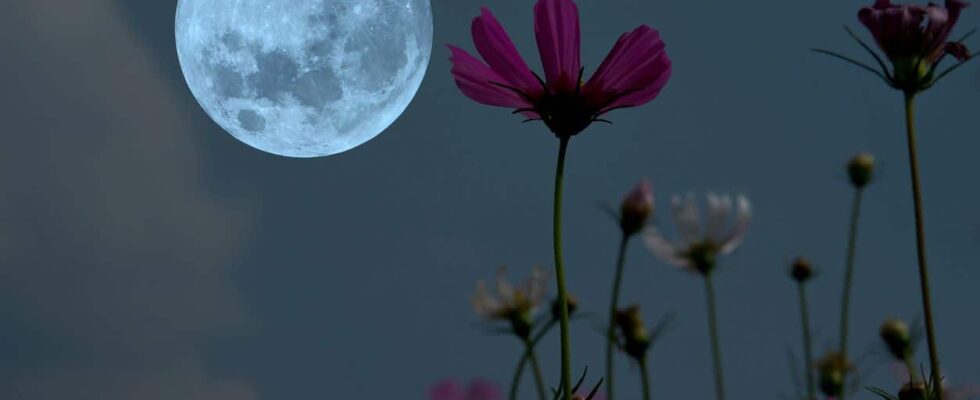
Gardening with the moon
Thanks to the lunar calendar, you will be able to take into account the different influences of the moon to know the days on which certain tasks must be carried out for greater efficiency. Let’s take a look at the elements that should not be overlooked.
The movements of the moon
You may have noticed that the moon sometimes appears higher in the sky and sometimes lower. This is because for 13.5 days the moon rises in the sky until it reaches its highest point. We then speak of a waxing or ascending moon. Following the same movement, the sap then rises in the branches. Once the highest point is reached, the moon will descend to its lowest point. We then speak of a waning moon. Logically, the sap will simultaneously descend towards the roots. As you will have understood, these up and down movements therefore have a first impact on the tasks to be carried out in the garden.
The lunar cycle
At the same time, the moon follows cycles of 29.53 days. It goes from one new moon to the next through the full moon stage. The moon is first waxing, that is, it goes from new moon to full moon, then it is waning when it goes from full moon to new moon. As part of your gardening work, the waxing moon period is conducive to harvesting, while the waning moon period is conducive to fertilization.
The constellations
Throughout its trajectory, the moon passes in front of different constellations. It is this passage in front of the constellations which makes it possible to determine the fruit, flower, leaf or root days, that is to say the best days for the latter.
Monthly lunar events
Finally, every month, the sky is the setting for various events during which it is not recommended to garden, at the time of the event itself, but also 5 hours before and after.
It is :
- the apogee: when its distance from the earth is maximum. The lunar attraction is the weakest. This will happen on May 17 at 8:58 p.m.;
- perigee: when its distance from the earth is minimum. The lunar attraction is the strongest. This will happen on May 5 at 12:04 a.m.;
- the lunar node: when the elliptical orbit described by the earth around the sun intersects that of the moon.
Moon calendar
First half of May
| Date | Moon | Type of day | What to do in the garden? |
| Wednesday May 1 Thursday, May 2 before 2:47 p.m. | Rising moon | Root days |
|
| Thursday, May 2 after 2:47 p.m. Friday May 3 Saturday May 4 before 4:09 p.m. | Rising moon | Flower days |
|
| Saturday May 4 after 4:09 p.m. Sunday May 5 before 6:45 p.m. | Rising moon | Leaf days |
|
| Sunday May 5 after 6:45 p.m. | Rising moon | Ascending node and perigee | Stop gardening until Monday, May 6 at 5:10 a.m. |
| Monday May 6 | Rising moon | Leaves Day | You can do the same sowing as on May 4 and 5. |
| Tuesday May 7 Wednesday May 8 until 6:23 p.m. | Rising moon | Fruit Days |
|
| Thursday May 9 Friday May 10 Saturday May 11 (Rising moon until 9:40 a.m. then waning moon) | Rising moon | Root days |
|
| Sunday May 12 | Descending Moon | Flower day |
|
| Monday May 13 Tuesday May 14 | Descending Moon | Leaf days |
|
| Wednesday May 15 | Descending Moon | Fruit day | Plant eggplants, chili peppers, peppers, tomatoes, physalis, cucumbers, pickles and melons. |
Second half of April
| Date | Moon | Type of day | What to do in the garden? |
| Thursday May 16 Friday May 17 before 3:50 p.m. | Descending Moon | Fruit days |
|
| Friday May 17 after 3:50 p.m. | Descending Moon | Apogee | Stop gardening |
| Saturday May 18 Sunday May 19 before 1:30 p.m. | Descending Moon | Root days |
|
| Sunday May 19 after 1:30 p.m. | Descending Moon | Descending node | Stop gardening. |
| Monday May 20 Tuesday, May 21 before 5:59 p.m. | Descending Moon | Root days |
|
| Wednesday 22 May | Descending Moon | Flower day |
|
| Thursday May 23 (Flower day until 10:50 a.m., then leaf day) Friday May 24 (Flower day until 10:50 a.m., then leaf day) Saturday, May 25 before 11:47 a.m. (Leaf day until 11:47 a.m., then fruit day) | Descending Moon | Leaf days then fruit |
|
| Saturday May 25 after 11:47 a.m. | Waning moon until 9:49 p.m., then waxing moon | Fruit day |
|
| Sunday May 26 Monday May 27 | Rising moon | Fruit days |
|
| Tuesday May 28 Wednesday May 29 (Leaf Day) | Rising moon | Flower days |
|
| Thursday May 30 Friday May 31 | Rising moon | Flower days |
|

